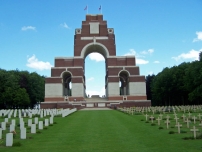| First Name: | Horace William | Last Name: | FOWLER | |
|---|---|---|---|---|
| Date of Death: | 16/09/1916 | Lived/Born In: | Dalston | |
| Rank: | Private | Unit: | Middlesex7 | |
| Memorial Site: | Thiepval Memorial, France | |||
Current Information:Born-Dalston
The Battle of the Somme (July-November, 1916) By the beginning of September, 1916, the Battle of the Somme had been raging for two months. Thousands of men had already been killed or wounded or were simply missing, never to be seen again and and just a few square miles of the French countryside, all in the southern part of the battlefield, had been captured from the enemy. Mistakes had been made by the various commanders and would be continued to be made but there was no turning back as the British, Australians, South Africans, New Zealanders and Canadians carried on battering away at the German defences in the hope of a breakthrough, So it continued all the way through to November with nearly every battalion and division then in France being drawn into it at some stage. In the end the German trenches had been pushed back a few more miles along most of the line but the cost in lives had been staggering. By the end of the fighting in November, 1916, British Army casualties numbered over 400,000, killed, wounded and missing. The Battle of Flers-Courcelette (15-22 September, 1916) On 15th September, 1916, the offensive on the Somme was renewed with a full scale attack on the German third line of defences. Four Army Corps were used on a front that stretched from Combles, through the village of Flers and on to Courcelette.. The artillery barrage that preceded this attack was more concentrated than that on 1st July and the attack itself was more successful. The villages of Flers, Martinpuich and Courcelette were captured and the enemy was finally pushed out of High Wood, but the breakthrough was not achieved and the reality was that when the battle ended on 22nd September, the front line had just been moved forward a mile or so. The battle is notable for being the first time that tanks were used. At the beginning of the Battle of Flers-Courcelette, 56th Division attacked on the extreme right of the British line, next to the French, with the task of forming a defensive flank along the north-west slopes of the Combles Ravine. The 1st London battalion of 167 Brigade attacked on the left of the divisional front, with the objective of extending this defensive flank northwards through Bouleaux Wood. They had two tanks attached to assist them in this task but one of them split a track while moving up and could not take part and the other got as far as the German line where it was hit and abandoned. At 6.20am, 1st London attacked behind an ineffectual creeping barrage but when they closed on the enemy trench they found it undamaged and fully manned. They were stopped in their tracks by a combination of wire entanglements and machine-gun fire. At 8.20am, two companies of the 7th Middlesex battalion were sent forward to pass through 1st London and clear Bouleaux Wood but with the enemy still occupying the wood in strength, they stood no chance. Neither did the other two companies who were sent in later and all they could do was reinforce the line of 1st London. Realising the hopelessness of the situation, especially as units on their left had not made sufficient progress, the attack was called off. Unfortunately this news did not reach the 8th Middlesex battalion, the third battalion of 167 Brigade, who at 1.40pm renewed the assault, advancing from Leuze Wood through the new line held by 1st London and 7th Middlesex. They too were hit by ferocious machine-gun fire from Bouleaux Wood and from their flanks and were unable to make any progress and were eventually forced back to Leuze Wood. On the following day, 8th Middlesex took over the line held by 167 Brigade and 7th Middlesex moved back to a line between Falfemont Farm and Wedge Wood to reorganise and count the full cost of the battle. The deaths of many men from the battalion, including Horace Fowler, are shown on the records as 16th September but it is much more likely that they were killed on 15th September. |
||||
| « Back to Search Results | ||||
| If you think any of the information shown here is incorrect, Click Here to submit your amends and comments | ||||




